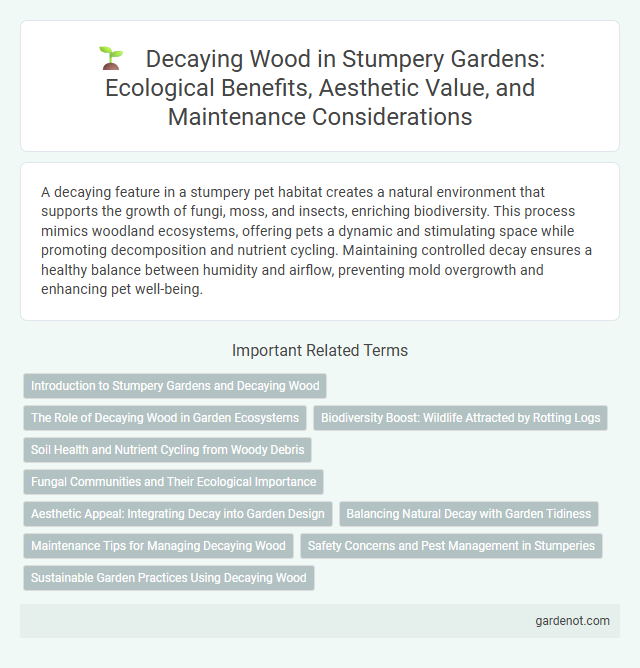A decaying feature in a stumpery pet habitat creates a natural environment that supports the growth of fungi, moss, and insects, enriching biodiversity. This process mimics woodland ecosystems, offering pets a dynamic and stimulating space while promoting decomposition and nutrient cycling. Maintaining controlled decay ensures a healthy balance between humidity and airflow, preventing mold overgrowth and enhancing pet well-being.
Introduction to Stumpery Gardens and Decaying Wood
Stumpery gardens showcase the natural beauty of decaying wood, transforming fallen tree trunks and branches into intricate landscape features. Decaying wood fosters a unique habitat for fungi, insects, and mosses, enriching garden biodiversity while providing an organic, textured aesthetic. This sustainable gardening approach emphasizes ecological balance by repurposing dead wood to create captivating, environmentally beneficial garden art.
The Role of Decaying Wood in Garden Ecosystems
Decaying wood plays a crucial role in garden ecosystems by providing habitat and nutrients essential for various fungi, insects, and micro-organisms. This organic matter fosters biodiversity, supporting species that contribute to soil health and plant growth. Incorporating decaying wood into stumperies enhances these natural processes, promoting a balanced and thriving garden environment.
Biodiversity Boost: Wildlife Attracted by Rotting Logs
Decaying logs in a stumpery create vital habitats that significantly boost local biodiversity by providing shelter and food for insects, fungi, and small mammals. These rotting features attract various species such as beetles, woodlice, and amphibians, fostering a complex ecosystem essential for ecological balance. The decomposition process enriches soil nutrients, supporting plant growth and promoting a thriving wildlife community.
Soil Health and Nutrient Cycling from Woody Debris
Decaying woody debris in a stumpery plays a crucial role in enhancing soil health by fostering microbial diversity and improving soil structure. The gradual breakdown of wood releases essential nutrients, supporting nutrient cycling that benefits surrounding plants. This organic matter enriches the soil with carbon, nitrogen, and phosphorus, sustaining a balanced ecosystem and promoting robust plant growth.
Fungal Communities and Their Ecological Importance
Fungal communities in stumperies play a crucial role in decomposing decaying wood, facilitating nutrient cycling and soil enrichment. These fungi break down lignin and cellulose, promoting biodiversity by providing habitats and food sources for various invertebrates and microorganisms. Their ecological importance extends to forest regeneration, enhancing ecosystem resilience and supporting complex trophic networks.
Aesthetic Appeal: Integrating Decay into Garden Design
Stumperies highlight decaying wood as a central aesthetic element, creating a naturalistic and textured landscape that enhances garden biodiversity. Incorporating rotting tree stumps, moss, and fungi not only adds visual depth but also fosters microhabitats for insects and small wildlife. This intentional use of decay transforms gardens into dynamic ecosystems where organic decomposition becomes an integral part of artistic design.
Balancing Natural Decay with Garden Tidiness
A stumpery showcases the beauty of natural decay by artfully arranging rotting wood and fungi, creating a habitat for wildlife while maintaining garden aesthetics. Balancing natural decay with garden tidiness involves selectively placing decomposing elements to prevent overgrowth and preserve pathways. Strategic design ensures that the decaying feature enhances biodiversity without compromising the overall appeal of the garden.
Maintenance Tips for Managing Decaying Wood
Regularly inspect decaying wood in a stumpery to identify soft spots or fungal growth early. Apply wood preservatives and fungicides designed for outdoor use to slow decay while maintaining the natural aesthetic. Ensure proper drainage and airflow around the wood to prevent moisture buildup that accelerates rot.
Safety Concerns and Pest Management in Stumperies
Decaying wood in stumperies creates a unique habitat but poses safety concerns such as structural instability and potential sharp edges that require regular inspection. Effective pest management involves monitoring for wood-boring insects, fungi, and rodents, which can accelerate decay and spread to surrounding plants. Implementing controlled moisture levels and removing severely compromised stumps helps maintain the stumpery's ecological balance and visitor safety.
Sustainable Garden Practices Using Decaying Wood
Decaying wood in stumperies fosters rich biodiversity by providing essential habitats for fungi, insects, and microorganisms, enhancing soil health through natural decomposition. Incorporating these sustainable garden practices reduces waste and promotes nutrient cycling, supporting resilient ecosystems and reducing the need for chemical fertilizers. Utilizing decaying wood strategically in garden design helps maintain ecological balance and encourages organic matter regeneration.
Decaying feature Infographic

 gardenot.com
gardenot.com